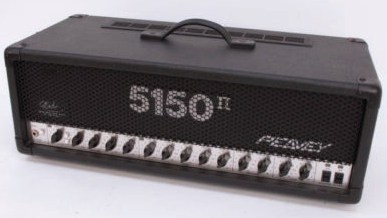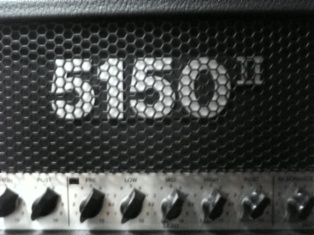Peavey 5150 II Tube Amp Head Review
Despite the lead singer hoopla that may be brewing in the Van
Halen camp at any given moment, the name “Edward Van Halen”
still draws a good deal of attention. So when it was announced
that Peavey and Eddie had teamed up again to whip up a
brand-spankin’ new 5150 amplifier, guitar fans worldwide
were clamouring to get a peek (or should we say a listen)
of the new creation.
Such was the case last January at the annual NAMM
(National Association of Music Merchants) event in
Los Angeles. When Edward appeared at the Peavey booth
to debut a prototype of the 5150 II, hundreds upon
hundreds of show goers crammed themselves around the
cubicle attempting to catch a glimpse of the renowned
guitarist and his wares. NAMM attendants claimed to be
blown away by the otherworldly sounds emanating from the
booth (hey, it doesn’t hurt to have Eddie Van Halen
playing through the amp. Shit, he could jam through a
Radio Shack amp and still make it sound amazing…).
Hopes were high for Edward’s latest “masterpiece”.
Then the release date had gotten pushed back several months,
frustrating those would like to test drive it ourselves.
Now that we have, is it worth the wait? Well…
Before we get to the nitty gritty, let’s see how it’s
different from the original 5150. The first amp housed
a standard four 6L6 power amp tubes, and so does the II;
but while the 5150 contained only five 12AX7 preamp tubes,
the 5150 II adds one for a total of six 12AX7’s.
The 5150 featured a three-band EQ, whereas the 5150 II has
two such EQ’s (one each for the rhythm and lead channels)
for better fine-tuning. There are separate Resonance and
Presence controls for the rhythm and lead channels on the
newer model, while the previous possessed only one set of
such controls. The two models share the same bright/crunch
controls (on the rhythm channel) and pre/post gain controls
(both channels). The 5150 II allows the user to turn the
crunch option on and off with the footswitch (a handy plus),
while the other didn’t. The 5150 offered two input jacks,
but the 5150 II only has one (Peavey and Edward did this
for some reason or another; perhaps because of lack of room
on the amp’s front?). Both models have virtually the same
rugged casings; so if you view each one “from the knobs up”,
you can easily mistake the two for each other.
That last statement can apply to their lead channel sound,
as well. Sorry, folks; I cannot tell any difference between
the two. I’m not implying that it’s bad in any way. In fact,
it’s rather good; the first 5150 amp absolutely cranked with
a badass, ball-shaking, tear-your-head-off-and-shit-down-your
neck tone that most players search for all their lives.
I ask, why bother purchasing the II if there’s no tonal
differences or improvements? There’s a case in the rhythm
channel: the sound is practically identical to the first
5150’s clean sound (admirable, but no where close to being
as incredible as an amplifier like the Carvin Legacy amp),
yet you have more power to make minute changes in the sonic
output. If that’s something you’d want, then go for it.
Most Van Halen fans will be playing through the excellent
lead channel anyhow, so the rhythm channel’s expanded
controls will matter little. My advice is: if you already
own a 5150, don’t bother laying down your hard-earned cash
for a 5150 II — it’s just not worth it for minor refinements.
If you own neither one, on the other hand, go with the II;
you’ll never know when you might want a bit more governance
over your tone.
This amp rates a solid 8.5 on a scale of one to ten in my book.
This rating could have been a 9 or even a 10 if reverb was added
(c’mon, Eddie, why not? We’d love it!) and if the clean sound
was dramatically improved. All in all, the Peavey 5150 series
boasts the best distorted tone available by any amps currently
in production.
SPECS:
Power : 120 watts RMS
Tubes : Four 6L6 power amp tubes and six 12AX7 preamp tubes
Graphic Equalizer : 3-band active EQ for each channel
(rhythm and lead)
Rhythm channel : Pre/post gain controls, bright/crunch switches
Lead Channel : Pre/post gain controls
Footswitch : Lead/rhythm channel select, Crunch on/off,
and Effects Loop; comes with 25′ cable
Dimensions : 10.3″ Height 26.5″ Width 11.9″ Depth
Weight : 48 lbs.
See also:
Related:
Peavey Classic 30/112 Amplifier
If you’re looking for a more affordable Tube Amp then see this roundup.



